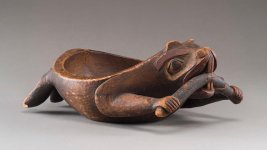Hi and thank you in advance for your thoughts and input on this. I am trying to find more information on this piece. It’s a nice old piece. Made of a stone pottery type material. Has wear from being used. On back looks like someone carved into it Beaver Oil Bowl Alaska and then another word. It is around 7.5 inches. Hoping someone may have some insight. Great piece.
Attachments
-
 8A4C0950-AD15-4164-8EEC-F97580F7BE57.jpeg1.1 MB · Views: 166
8A4C0950-AD15-4164-8EEC-F97580F7BE57.jpeg1.1 MB · Views: 166 -
 DC39DFB6-A09E-4E4B-894E-964951FD06C4.jpeg1.2 MB · Views: 74
DC39DFB6-A09E-4E4B-894E-964951FD06C4.jpeg1.2 MB · Views: 74 -
 EF0F240D-E747-4935-A6B2-05489E7D52D1.jpeg940 KB · Views: 81
EF0F240D-E747-4935-A6B2-05489E7D52D1.jpeg940 KB · Views: 81 -
 9ACFDF2C-A265-4F09-8838-CDA2B4CD2FB9.jpeg1.6 MB · Views: 88
9ACFDF2C-A265-4F09-8838-CDA2B4CD2FB9.jpeg1.6 MB · Views: 88 -
 4A5E4A49-B884-4426-BE40-0764603CDE9C.jpeg1.1 MB · Views: 88
4A5E4A49-B884-4426-BE40-0764603CDE9C.jpeg1.1 MB · Views: 88












